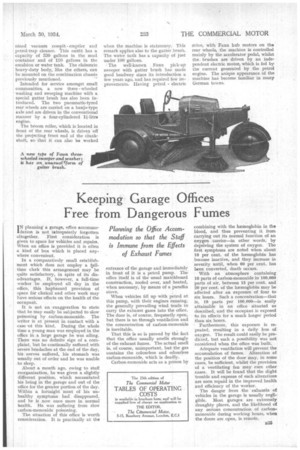Keeping Garage Offices Free from Dangerous Fumes
Page 31

If you've noticed an error in this article please click here to report it so we can fix it.
Planning the Office Accommodation so that the Staff is Immune from the Effects of Exhaust Fumes
INplanning a garage, office accommodation is not infrequently forgotten altogether. First consideration is given to space for vehicles and repairs. When an office is provided it is often a kind of box which is placed anywhere convenient.
In a comparatively small establishment which does not employ a full. time clerk this arrangement may be quite satisfactory, in spite of its disadvantages. If, however, a full-time worker be employed all day in the office, this haphazard provision of space for clerical and other work may Pave serious effects on the health of the occupant.
It is not an exaggeration to state that he may easily be subjected to slow poisoning by carbon-monoxide. The writer is at present in contact with a case .of this kind. During the whole time a young man was employed in the office in a large garage be was ailing. There was no definite sign of a complaint, but he continually suffered with severe headaches at the end of the day, his nerves suffered, his stomach was usually out of order and he was unable to sleep.
About a month ago, owing to staff reorganization, he was given a slightly different position, which necessitated his being in the garage and out of the office for the greater portion of the day. Within a fortnight most of his unhealthy symptoms had disappeared, and he is now once more in normal health. He was suffering from slow carbon-monoxide poisoning.
The situation of this office is worth consideration. It is practically at the
entrance of the garage and immediately in front of it is a petrol pump. The office itself is of the usual matchboard construction, roofed over, and heated, when necessary, by means of a paraffin stove.
When vehicles fill up with petrol at this pump, with their engines running, the generally prevailing wind tends to carry the exhaust gases into the office. The door is, of course, frequently open, but there is no through ventilation and the concentration of carbon-monoxide is inevitable.
That this is so is proved by the fact that the office usually smells strongly of the exhaust fumes. The actual smell is, of course, unimportant, but the gas contains the colourless and odourless carbon-monoxide, which is deadly.
Carbon-monoxide acts as a poison by
combining with the Imnoglobin in the blood, and thus preventing it from carrying out its normal function of an oxygen carrier—in other words, by depriving the system of oxygen. The first symptoms are noted when about 10 per cent. of the hmmoglobin has become inactive, and they increase in severity until, when 60 per cent, has been converted, death occurs.
With an atmosphere containing 10 parts of carbon-monoxide in 100,000 parts of air, between 15 per cent. and 20 per cent of the lautoglobin may be affected after an exposure of four to six hours. Such a concentration—that is, 10 parts per 100,000—is easily attainable in an office situated as described, and the occupant is exposed to its effects for a much longer period than six hours.
Furthermore, this exposure is repeated, resulting in a daily loss of oxygen. The result could easily be predicted, but such a possibility was not considered when the office was built.
Adequate ventilation will prevent the accumulation of fumes. Alteration of the position of the door may, in some cases, be sufficient, whilst the provision of a ventilating fan may cure other cases. It will be found that the slight trouble and expense of such alterations are soon repaid in the improved health and efficiency of the worker.
The danger from the exhausts of vehicles in the garage is usually negligible. Most garages are extremely draughty places, and the likelihood of any serious concentration of carbonmonoxide during working hours, when the doors are open, is remote.












































































